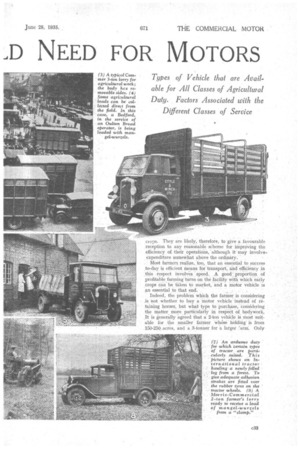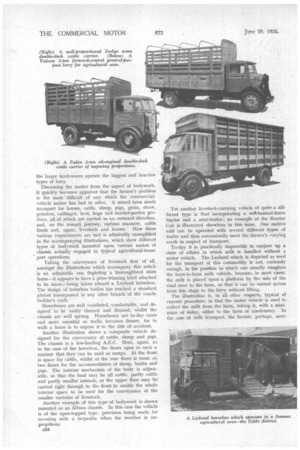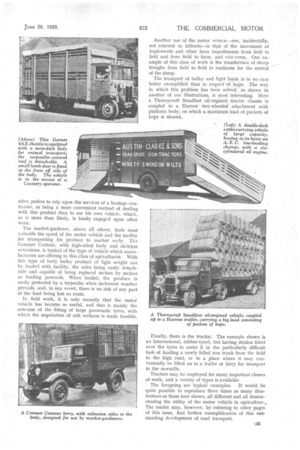THE FARMER'S MANIFC ,D NEED FOR MOTORS
Page 82

Page 83

Page 84

Page 85

If you've noticed an error in this article please click here to report it so we can fix it.
The Bodybuilder Efficiently Meets Many Specialized Requirements by Providing a Wide Variety of Types of Bodywork for Agricultural Vehicles Types of Vehicle that are Available for All Classes of Agricultural Duty. Factors Associated with the Different Classes of Service
T . HERE is no. industry in this country which.suften, _ so intensely from industrial depression as that of agriculture and none which responds so readily
, ,
whens a period of prosperity reigns. The farmer buyrs with the money he receives for his .crops, and those who deal with agriculturists are well aware of that fact. It is a normal feature of their business procedureto expect liquidation of a farmer's accounts during that
• part of the year when payment is made for wheat, oats, barley, beet, potatoes and the like. It follows, therefore, that the farmer is apt to endeavour to do without the more exp'ensive items of equipment while times are • bad, and take advantage of More prosperous times to make good any deficiency in his gear. .
,There are signs that the effect of the current increas
ing industrial ' activity is reacting On agriculture.. farmers have in sight a period of good prices for good (5) The collection of niilk direct from farms is a service for which the road motor is largely employed. In this instance, a Thornycroft Bulldog 3.-ton platform lorry is seen dealing with a load of milk in churns. The vehicle is operated by a Chester haulage contractor. (5) A Leyland Cub collecting milk at a Lancashire farm; the churns are carried in two tiers. clops, They are likely, therefore, to give a favourable reception to any reasonable scheme for improving the efficiency of their operatiOns; although it may involve. expenditure somewhat above the ordinary.
. Most farmers realize, "too, that an essential to success to day is efficient means for 'transport, and efficiency in this respect involves speed. A good. proportion of profitable farming turns on the facility with which early .crops can be taken to market, and a motor vehicle is an essential to that end.
Indeed, the problem which the farmer is considering is not whether to buy a motor vehicle instead of retaining horses, but what type to purchase, Considering the matter, more particularly in respect of bedywork.
,t1 It is generally agreed that a 2-ton vehicle is Mcist suitable for the smaller farmer whOse holding is from
150-250 acres, and a 3-tonner for a larger _'arrn. Only the larger landowners operate the biggest and heavies' types of lorry.
Discussing the matter from the aspect of bodywork, it quickly becomes apparent that the farmer's problem is the most 'difficult of any which the commercialvehicle maker has had to solve. A mixed farm needs transport for horses, cattle, sheep, pigs, grain, straw, potatoes, cabbages, beet, hops and market-garden produce, all of which are carried in an outward direction, and, on the inward journey, various manures, cattle foods and, again, livestock and horses. How these various requirements are Met is admirably exemplified in the accompanying illustrations, which show different types of bodywork mounted upon various makes of chassis actually engaged in typical agricultural-transport operations.
Taking the conveyance of livestock first of 'all, amongst the illustrations which accompany this article is an admirable one depicting a thoroughbred shire horse—it appears to have a prize-winning label attached to its mane—being taken aboard a Leyland horsebox. The design of horsebox bodies has reached a standard almost unsurpassed. in any other branch. of the coachbuilder's craft.
Horseboxes are well ventilated, comfortable, and designed to be easily cleaned and drained, whilst the chassis are well sprung. Horseboxes are to-day more and more essential as traffic becomes denser, for to walk a horse is to expose it to the risk of accident.
Another illustration shows a composite vehicle designed for the conveyance of cattle, sheep and pigs. The chassis is a low-loading A.E.C. Here, again, a3 in the case of the horsebox, the doors open in such a manner that they can be used as ramps. At the front is space for cattle, whilst at the rear there is room on two floors for the accommodation of sheep, lambs and pigs. The interior mechanism of the body is adjustable, so that the load may be all cattle, partly cattle and partly smaller animals, or the upper floor may be carried right through to the front to enable the whole interior space to be used for the conveyance of the smaller varieties of livestock.
Another example of this type of bodywork is shown mounted on an Albion chassis. In this case the vehicle is of the open-topped type, provision being made for covering with a tarpaulin when the weather is unpropitious;
Yet another livestock-carrying vehicle of quite a different type is thatincorporating a nnithanical-horse tractor and a semi-trailer; an example of the Karrier Cob is illustrated elsewhere in this issue. One motive unit can be operated with several different types of trailer and thus conveniently meet the farmer's varying needs in respect of transport.
To-day it is practically impossible to conjure up a state of affairs in which milk is handled without a motor vehicle. The Leyland which is depicted as used for the transport of this commodity is not, curiously enough, in the position in which one usually imagines the farm-to-farm milk vehicle, because, in most cases, the milk is placed upon a platform by the side of the road near to the farm, so that it can be moved across ftorn this stage to the lorry without lifting.
The illustration is, in all other respects, typical of current procedure, in that the motor vehicle is used to collect the milk from the farm, taking it, with a minimum of delay, either to the farm or condensery. In the case of milk transport, the farmer, perhaps, more
often prefers to rely upon the services of a haulage contractor, as being a more convenient method of dealing with this product than to use his own vehicle, which, as is more than likely, is busily engaged upon other work.
The market-gardener, above all others, finds most v aluable the speed of the motor vehicle and the facility for transporting his produce to market early. Th?... Commer Centaur, with high-sided body and skeleton extensions, is typical of the type of vehicle which manti• facturers are offering to this class of agriculturist. With this type of body bulky produce of light weight can be loaded with facility, the sides being easily detachable and capable of being replaced section by section as loading proceeds. When loaded, the produce is ea ily protected by a tarpaulin when inclement weather
• prevails, and, in any event, there is no risk of any part of the load being lost en route.
In field work, it is only recently that the motor vehicle has become so useful, and that is mainly the outcome of the fitting of large pneumatic tyres, with which the negotiation of soft surfaces is made feasible.
Another use of the motor vehicle—one, incidentally, not referred to hitherto—is that of the movement of implements and other farm impedimenta from field to field and from field to farm, and vice-versa. One example of this class of work is the transference of sheep troughs from field to field in rea:diness for the arrival of the sheep.
The transport of bulky and light loads is in no case better exemplified than in respect of hoPs. The way in which this problem has been solved, as shown in another of our illustrations, is most interesting. Here Thornycraft Steadfast oil-engined tractor chassis is coupled to a Harrow two-wheeled attachment with platform body, on which a maximum load of pockets of hops is stowed.
Finally, there is the tractor. The example shown is an International, rubber-tyred, but having strakes fitted over• the tyres to assist it in the particularly difficult task of hauling a newly felled tree trunk from the field to the high road, or to a place where it may conveniently be lifted on to a trailer or lorry for transport to the sawmills.
Tractors may be employed for many important classes of work, and a variety of types is available.
The foregoing are typical examples. It would be quite possible to reproduce three times as many illustrations as those here shown, all different and all demonstrating the utility of the motor vehicle in agriculture.. The reader may, however, by referring to other pages of this issue, find further exemplification of this outstanding developtnent of road transport.




























































































































































